I started photographing sometime around the turn of 2000/2001. My first attempts were of course analogue – I used the equipment of my Dad, who had a traditional photographic darkroom and several cameras.
I quickly caught the bug and found people (Gliwice Photographic Group) among whom I could develop my talent. I took photographs, developed negatives and made darkroom prints. Above all, I created portraits (pestering my closest female friends and forcing them to pose) and images of the city.
When I realised in 2006 that I no longer wanted to be a full-time social worker and that I couldn’t stand the structure, the bureaucracy and the starvation wages, I decided to change profession.
When I asked myself what else I could do and which direction I could go in, the answer was photography.
I don’t remember how I came up with the idea of becoming a photojournalist, but I figured the only way to get into the profession quickly was through assignments for the media. Working as a photojournalist became an obsession for me. I watched them taking pictures at various events, focusing their attention on the people and what was happening in front of their lenses.
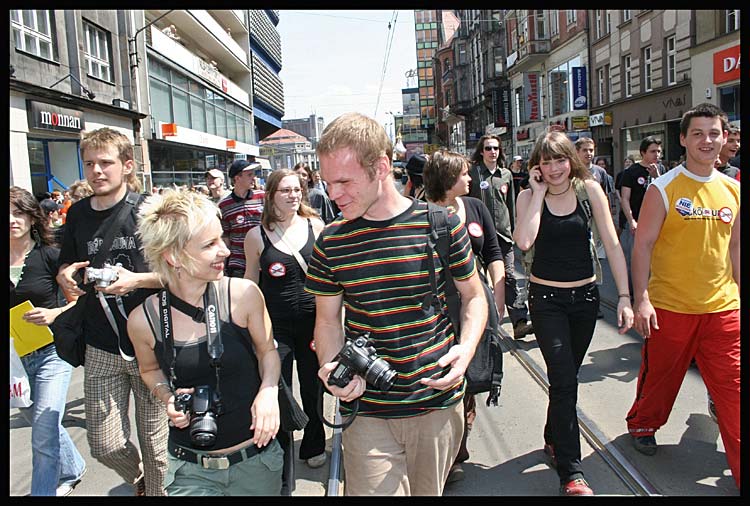
[This photo is iconic for me. Summer 2006 – I’m about to leave my full-time job and commit myself one hundred percent to photojournalism. I’m walking next to Marcin Tomalka, a long-time Gazeta Wyborcza photojournalist, at a demonstration in Katowice. Unfortunately I don’t know who took the photo.]
That time was ultra-important to me. The decision to put together a portfolio in a few months, give notice, apply for a start-up grant and open a business – sounds a bit like a madwoman’s dream. And yet I had a deep conviction that this was the right path.
This story is multifaceted, I won’t write about it in detail here, but I invite you to watch an hour-long interview with me by Antoni Kreis as part of the series Let’s get to know each other / ZPAF (sorry, only in Polish): HERE.
In this conversation, I talk mainly about the people who have contributed to my development as a photographer, who have left important traces on my path.
Did I want a company? No. I didn’t think of myself in the ‘entrepreneur’ category. But it turned out to be the only way to realise my plan. Firstly, I had no chance of getting a full-time position at a newspaper, at the time photographers were being laid off rather than hired and the ‘self-employed’ option was readily available. Other forms of temporary contracts were not an option.
By opening a business, I was able to take advantage of grants. This was very important for me because, apart from analogue equipment, I had nothing. I had to buy a digital SLR camera, lenses, a laptop, a car.
Press
I formally launched the business in December 2006, but I had already started working with Gazeta Wyborcza and the photo agency ‘Edytor’. Then came Echo Miasta Katowice and single publications in other newspapers.
It was a brilliant and the best school of photography. I tackled a variety of subjects, often doing something for the first time. Fortunately, I was stubborn and learned quickly. In the first few months I fed mainly on adrenaline with cortisol sauce.
An exciting, important and crucial time, but very demanding. I was bearing the cost of such a lifestyle, of course, being fully available 24/7 – I had no time for friends or even analogue photography, it was difficult to plan anything, I rarely had a day off.
Although my running costs were low at that time, I wasn’t earning much, I invested in better equipment. I knew that this would bring results, that I was learning a lot.
I worked for the media for about five years in total.
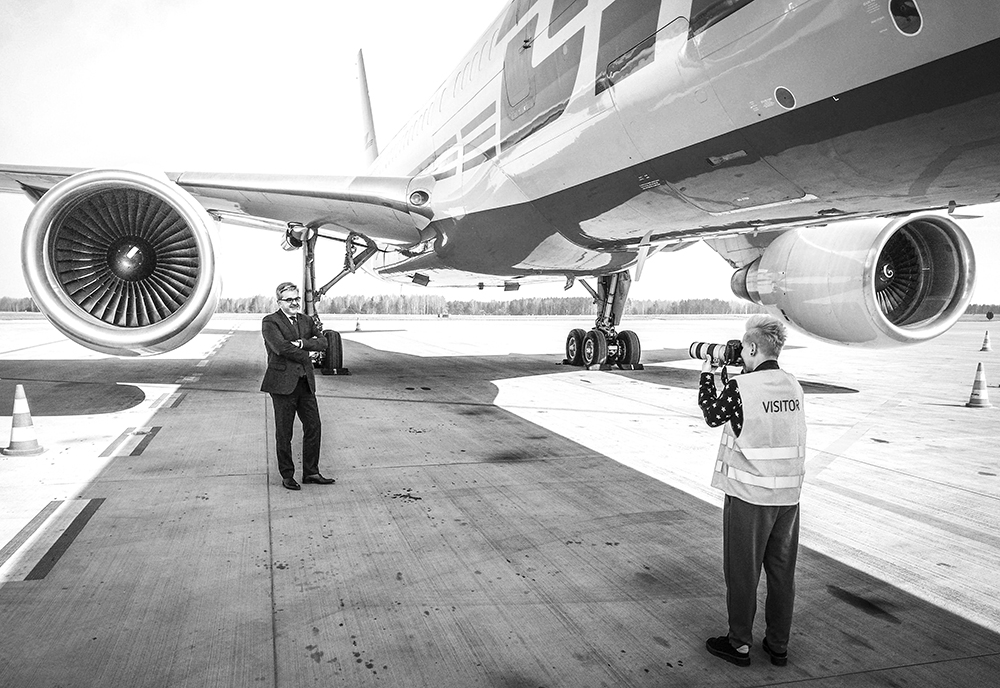
Fotoreportages for companies
There came a time when the press had shrunk so much that I was no longer able to make a living from it. I considered various options, but the closest I came was reportage, which after all is a component of press photography.
I even did a few weddings at the time considering this field, but quickly came to the conclusion that it was totally not my direction.
Reportage at conferences, trade fairs, meetings and corporate celebrations for business clients became my daily routine. I travelled a lot in Poland at that time, expanding my area of operation beyond the borders of Silesia. There were also trips abroad.
I did thousands of reportages, smaller, full-day ones, at intimate or international events.
My working hours calmed down a little, as most of these collaborations were contracted in advance. There were occasional last-minute campaigns, but things started to calm down a bit.
I worked intensively and continuously with reportage until 2018. When I opened the Portrait Studio, the emphasis shifted to portraiture and stationary work at my location. I still occasionally do reportage work, but clearly portraiture has become my domain.
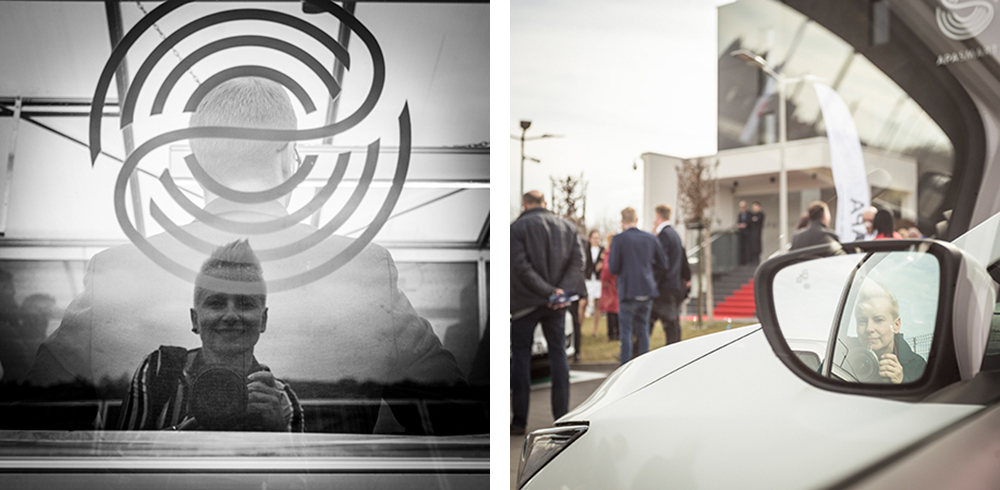
Architecture and interiors
My interest in architecture is a genetic thing. My parents were architects, so since childhood I have been accompanied by drawing boards, measuring tapes and conversations about buildings.
When I was still working in the press, I used to attend press conferences organised by the mayors of Katowice, in which they announced changes to the city, such as the demolition of the brutalist railway station.
In 2010, I received a scholarship from the Marshal of the Silesian Voivodeship in the field of culture, and with the help of my Dad, I started to travel around the cities of the conurbation, documenting post-war buildings, sculptures and mosaics.
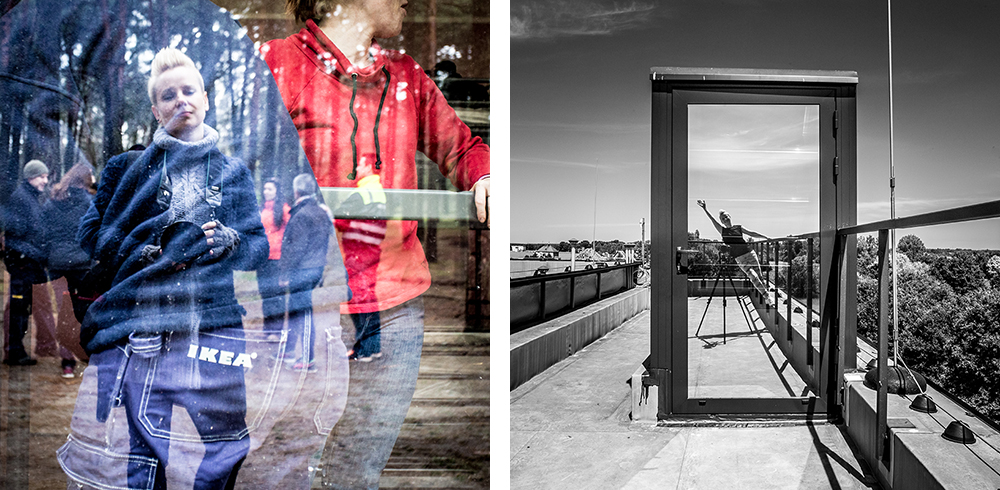
It quickly became apparent to me that I would really benefit from a specialised lens for photographing architecture, which would improve the work and the quality of the images. So I bought the right equipment and, having finished the project, I decided that I could also do this architecture commercially.
This area of photography proved to be a break from the hustle and bustle of events and demanding portrait work. I have done the most commissions of commercial spaces and interiors such as open-space offices, shops, restaurants, all kinds of offices such as medical for example.
I still enjoy architecture and interiors photography and welcome such commissions, and which you can find in my portfolio – although not displayed in a separate gallery – in the SEE tab on my website: HERE.
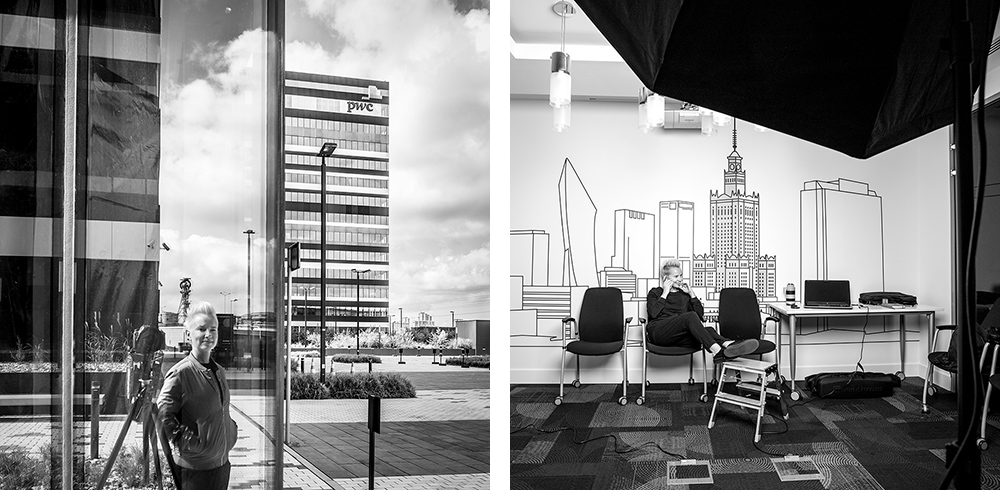
Portrait
This is where I started my adventure with photography. And even though I spent years working in other areas of photography, I feel that I have come full circle and returned to my roots.
In press photography, the portrait is also present, of course. I call it a reportage portrait because, like other subjects in this field, it arises quite spontaneously.
When I started photographing for companies, there were also questions about whether I could do portraits of people associated with the organisation in addition to reportage. So I had bought studio equipment long before I opened my Portrait Studio.
I travelled to companies, arranged studio sets in them and did portraits.

Over time, I felt that my own place where I could meet entrepreneurs who don’t have their own offices would be very useful. I also felt that I wanted to organise my working time, slow down and create a comfortable environment for myself and my clients.
In June 2018, I opened my Portrait Studio in Katowice. It’s a completely new chapter, a lot has changed, it’s the moment when I put the most important emphasis on portrait photography. Of course, I remember when, being a photojournalist, I thought that the studio and working with studio light was boring and without the dynamics of the street I would fall asleep. But – to reiterate – a lot has changed.
I value the slow philosophy, calmness, one-on-one contact with the person being photographed, I enjoy listening to the stories of my guests and having coffee with them. I am invariably delighted by the variety of human faces and personalities I get to look at up close.
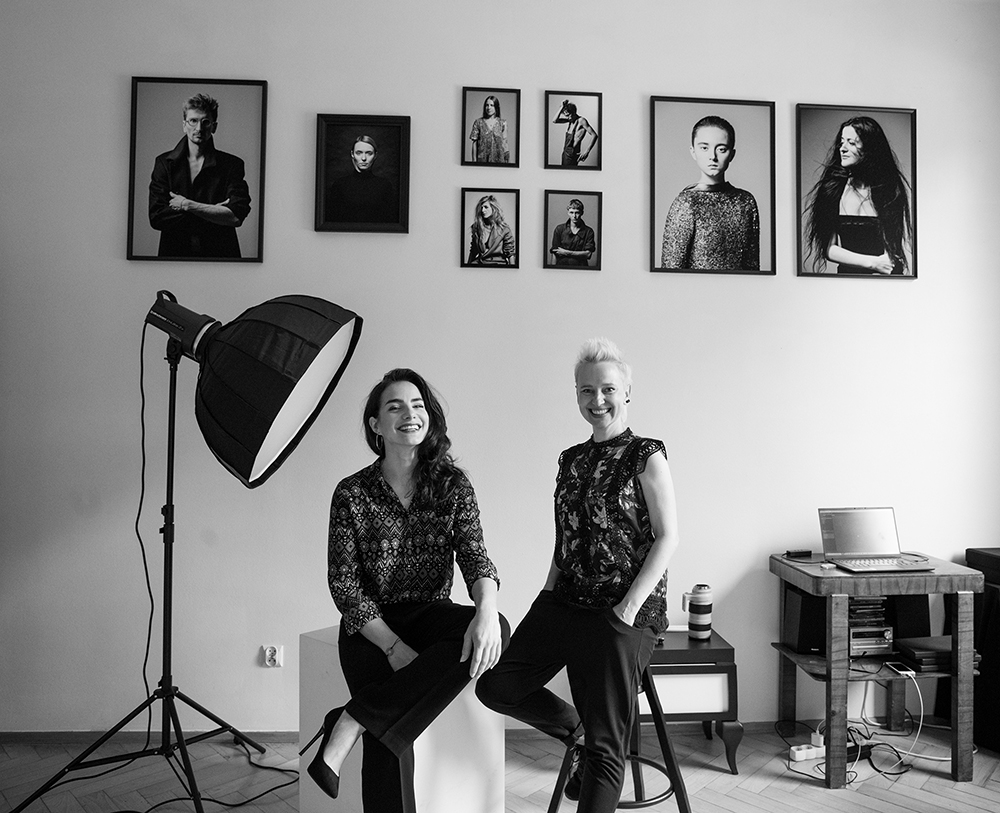
I specialise in business portraiture and create images for my clients’ websites, social media and printed materials. My personal projects are also grounded in portraiture.
I shoot in the studio or outdoors, digitally and analogue. I still develop negatives myself.
The line between commercial and personal is becoming increasingly blurred. My strength in commercial is becoming a very personal approach to how I interpret and create portraits.
I remember my dream from the early days of my photographic adventure, to make a living from art photography.
I have a feeling that I have fulfilled it.
———-
It is this December that the company I founded in 2006 celebrates its 18th birthday. And actually I’m celebrating this birthday, because in the case of a one-person business, combined with a personal brand and being an author, the company is me.
Over these eighteen years, I have accumulated a whole bagful of experience. My business has gone through several transformations, I’ve caught up with crises and doubts, and I’ve also enjoyed a huge number of successes.
In all this time, photography has been my only source of income. I don’t know if I can count how many people I have photographed, how many events and places.
Of course, a one-person business isn’t just – in my case – about photographing and post-processing. It’s also a huge amount of work: communicating and meeting clients, running the website, social media and the shop, writing the blog, running workshops, dealing with documentation (invoices, contracts, etc.), promo activities, strategy and trying to get away from the day-to-day to draw visions and plans. It’s also personal development, education, new competences.
And a whole bunch of crap, such as servicing my car (which is my work tool, after all), taking care of the studio or running to the parcel machine with a delivery. So it’s not just a crap.
To celebrate my anniversary, I have decided to write a series of texts about how I run my business, what difficulties I have encountered and what goes lightly. Where I get my inspiration from and where I look for answers. What values do I hold dear. What my typical working day looks like – do I even have such a thing as a typical working day. And I’ll probably catch a few more ideas in between. I’m not going to sugarcoat it, I’ve experienced some total fuck-ups 😉 Fortunately, moments of elation and happiness were more frequent.
Most often I take photographs in my Portrait Studio in Katowice. Sometimes I arrange studio conditions at the client’s company if we need the context of interiors in the photos or the client cannot come to the studio.
I also occasionally shoot portraits outdoors, although I use the above options far more often.
The title question can actually be extended: studio, company, other interiors or outdoor?

In the studio, we gain independence from hardly predictable weather conditions: rain or snow, but also heat, high winds, frost, and grey days.
It is so here (in Poland? in Silesia?) that it is usually wet for half a year and the sun can be absent for weeks. In summer, on the other hand, we get run down from the heat.
This year (2024) such a situation happened to me. I was photographing the management and team of GRENKE in Warsaw. In the original concept, we had planned – in addition to shooting in the company using a neutral backdrop and the office space – to shoot on the streets of Warsaw as well. End of June, 30-degree heat… The air was already so hot from the morning that we abandoned this part, replacing it with more shots in the interiors. No one felt like facing the high temperature, the strong sun and the make-up running off.
In the studio, we also won’t be surprised by sudden renovations in a public space, cleaning work outside or cars parked in such a way that they obscure the background – because it matters, of course, what is behind the person being portrayed.
Usually clients want modern buildings, interesting spaces, sometimes – but much less often – greenery. We have interesting architecture in Silesia, but the most attractive is at the same time the most recognisable. Some perceive it as an advantage in the form of a strong identification with their place of business, others do not want to show themselves in popular spaces.
In a studio setting, we don’t have to worry about all that, we can concentrate on our work in peace. Does it mean that I don’t photograph outdoors at all?
It happens to me, but rarely.
Photographs outdoors gain a context – of urban hustle and bustle, architecture, nature, which complements the portrait with a story, shows the person in a certain reality, carries the style of the place. This is attractive, but can sometimes be difficult in realisation.
The best approach in this case is plan B. That is, if it turns out that conditions are not conducive, it is more convenient to move to the studio rather than postpone the session and look for another date.
Personally, I like urban space and its multi-planarity. I have the genes of architects (my parents designed), so I can handle the solids that form the background and blend them nicely with the character of the photo. I give the example of my personal project URBAN YOGA, which I realised a few years ago in downtown Katowice. Take a peek HERE if you feel like it.
But back to the topic. Sometimes clients ask me to use the interiors of public or private places. This is probably the most complicated option. It involves either a paid rental or creating portraits in an environment that we don’t have exclusive rights to. In the case of the latter, you have to take into account other clients e.g. in a café (they shouldn’t be in the photos) and the lack of freedom to build a set (so as not to disturb others).
As well as the comfort of creating them, studio portraits also bring greater versatility through the use of neutral backgrounds. Sometimes it’s difficult to predict the contexts of future publications, so this neutrality can be useful. It’s also very practical, especially if the make-up of the team changes and new people come in. It is then easy to take the same portrait, in the same studio conditions, maintaining continuity and consistency in the series. I work with more than a dozen companies in this way. After a large session and having photographed a dozen / several dozen people, this tabloid can easily be supplemented with new people.
The conditions I have in my Studio are fully under my control. That is, when setting up the light I know 100% what the effect will be, I can focus on the aesthetic nuances and details that build the atmosphere of the portrait. This is by far the most comfortable option for me when creating portraits.
This option is also appreciated by clients. They have calmness, intimacy and a good atmosphere with me. This is important especially when the photo shoot causes tension and discomfort.
There are also times when I am packing up my equipment, going to a client’s company. This happens when we want to have the context of the place in the photo. I use the furnishings: furniture, colours, glazing, I can use daylight and/or studio light.
The second case when I go to a company happens most often when there is a need to portray a very large team. Such a session is very dense, I have little time per person, the pace is fast, so it’s more efficient to do it at the client’s place.
But the location has to meet certain conditions in terms of the size of the room and its height so that I can arrange the background and light. I always check it beforehand and we agree where specifically we will set up the studio.
Reading this text, you might get the impression that I most enjoy working in my Portrait Studio. And probably it is true, nevertheless it is sometimes good to take photographs in other settings for variety.

This text is illustrated with portraits of the writer Anna Cieplak. I was commissioned by Wydawnictwo Literackie for the publication of her novel Rozpływaj się (Melting Up).
Some of the photographs were taken in my studio, one of which ended up on the cover of the book.
In the outdoor space, however, we worked on the dinosaur sculptures, which refer to a scene in the book.
While we were comfortable working in the studio, the outdoors gave us a bit of a hard time. The photos were created in a hurry, catching moments when it rained a little less… 🙂 Deadlines limited us so we couldn’t postpone the session to another day, so we accepted these conditions and focused on what we had to do.
If you would like to read other texts in this series, please click on the ‘business portrait shooting’ category or HERE.
The Katowice JazzArt Festival 2020 promised to be amazing. At the invitation of Martyna van Nieuwland / Katowice Miasto Ogrodów, I was supposed to move into the space of the sounds of jazz and make a series of portraits of the artists taking part in the festival. I called it Faces of JazzArt. It was a beautiful proposition, because I was able to realise the theme within the framework of my One People Story project, on film, with a medium-format analogue camera, consistent with the whole series I have been creating since 2012 (you can find information about the project HERE).
At the beginning of March 2020, there was a concert weekend called before and then.. we remember what happened. All concerts were cancelled and my project was put on hold.
Over the following months, whenever possible, intimate events were held as part of the festival or artists gave concerts to the exclusion of the public, in front of the camera. In both 2020 and 2021, the festival took place between lockdowns, in a reduced version.
In order to be able to realise the initial objectives of this collaboration, I adapted to the changed conditions and took some portraits in 2020 and some in 2021.
Among those who stood in front of my lens then were Mikołaj Trzaska, Macio Moretti, Joanna Duda, Morris Kliphuis, Pola Dwurnik and Christopher Dell. And it is this meeting with Christopher that I would like to mention.
In spring 2021, Christopher Dell comes to Katowice for an artist residency as part of the festival. He is a German musician, a vibraphonist, but also an urbanist. As part of his residency, he is to spend a few days in my city. The time is not easy, the public spaces are closed, but Christopher has his time filled to the brim. He explores the urban space, talks to architects, musicians and artists, and creates a solo improvisation. He also finds time to meet with me, so I have the chance to portray him.
The portraits in the One People Story series are created quite spontaneously. I arrange the photo set in response to a situation, a place, a character I have met. In Christopher’s case, I knew that I wanted his portrait to be created with Katowice in the background; after all, the context of the city for an urbanist is obvious.
We meet in a building on Sejm Śląski Square, so I suggest we go outside and find a suitable set in the area. At the last minute I take a stool. Christopher is a tall man and I don’t want to photograph him from my lower perspective 😉
We don’t look for a place for long, we put the stool at the corner of Ligonia and Sienkiewicza streets, I ask Christopher to sit down. For a while I set the parameters in the camera, measure the light, frame. After a while, I count to three… and it’s done.
Another portrait is created, but I prefer this one.

The same day or the next, we spend a pleasant time in my Portrait Studio, which has replaced a café to us. We drink coffee and talk together with a few people, enjoying this spontaneous meeting, at a time so unfavourable for meetings.
Some time later I develop the negatives, print this photograph on my favourite paper cardboard and send it to Berlin to Christopher. When I ask for an address to send the portrait – no, I don’t mean by email 😉 – I usually spring a surprise. And this time it is the same.
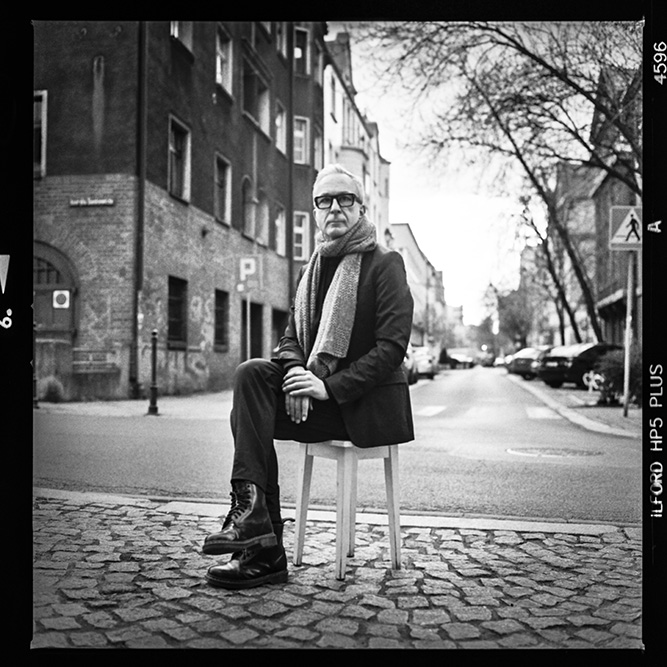
This is where the story could have ended, but another pleasant thing happened to me. More than a year later, I was contacted by the editor-in-chief of the German magazine JazzPodium. He wanted to publish Christopher’s portrait on the cover.
Among our arrangements, I was assured that the editors would make every effort to publish the photograph in its original frame, i.e. square. I was very keen on this. I treat each photograph in this series as a closed collection. This includes the frame, which is created by scanning a slightly larger area than just the frame of the photograph. I frame precisely when taking the photograph and do not crop it later.
My joy was great when this edition arrived from Germany. I think that keeping the full frame, arranging it on the cover and draping it in colour, looks great. The magazine was published in October 2022.
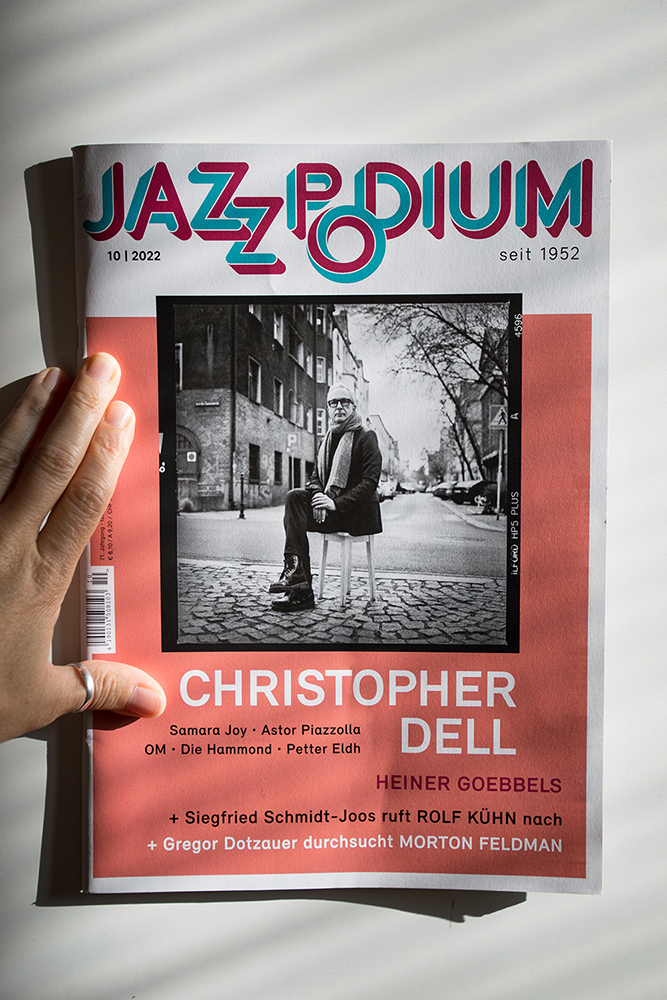
You know you need portraits to grow your brand and business, but completely clueless on how to go about it?
No problem. We’ll talk and everything will become clear.
An indispensable part of the cooperation is the creation of a concept for the shooting. Even if we are only talking about working on a single portrait. I need to know what your plans for publications are, whether the photos are to go on a website or be published in a trade magazine – the context is important. I ask about the company’s visual identity and branded graphic materials. But also about your style preferences and aesthetics. I want to know your vision and be sure that the style I work will suit you.
We can meet in person or online, talk on the phone, the important thing is that we discuss the details. Sometimes clients are surprised at how many questions I ask at this stage but, the better I understand what you need and what your expectations are, the more accurately I can convey this in the photographs.
I implement all the gathered information into the ideas for the photographs – the conversation stimulates my imagination, I replace words with images, so that at this stage I already propose specific solutions.
We build the scenario of the session, i.e. we plan the approximate final number of shots, we determine how they will differ from one another having at our disposal the light, the neutral background and its colours or the scenery of the place and, of course, the outfits, which can be more or less formal.
If I’m working with a team, we’re looking for a common denominator, a certain key that is visually shared by the whole team.
Photographs for business are meant to fulfil very specific tasks. To help you with your business and its development, to represent you in all kinds of publications, to carry a certain story that you want to convey to your audience.
So the work of preparing them should be precise. Of course, I also leave room for spontaneity during the shoot, and I’m open to ideas that come up at the photo creation stage. But certainly, good preparation will guarantee that the session time will be used to the full, effectively, and that the results will meet your expectations.
If you want to find more texts in this series, click on the CATEGORY “business portrait shooting” or HERE.
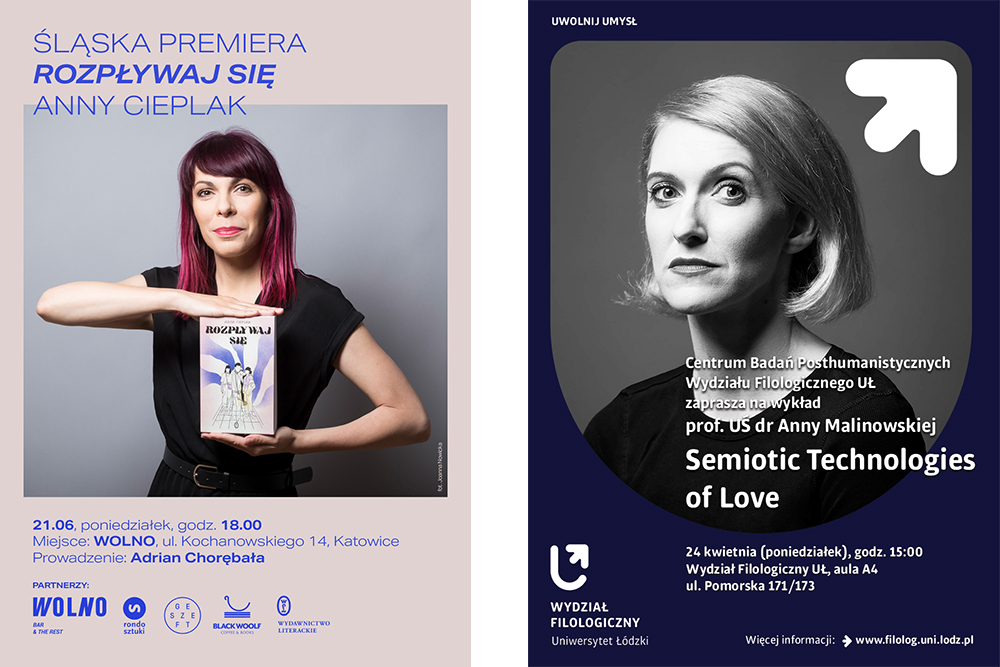
It is 2018 and Martin Fejer from the Est&Ost press agency writes to me and commissions me to take portraits of Szczepan Twardoch. The photos gonna be used as illustrations for an interview in the German newspaper Die Tageszeitung, on the occasion of the publication in Germany of the novel The King – with the German title Der Boxer. He also put me in touch with the journalist Philipp Fritz, who is to do this interview.
A few hours before the interview and shooting, I meet Philipp in Katowice and we start our collaboration with…. coffee. Philipp is German but speaks excellent Polish.
I take my companion to Gliwice, where we have an appointment with Szczepan Twardoch.
The journey is fun, to say the least. We drive in my car, hurtling down the road in total fog. It is January, but there is no snow. And I tell the story the whole way: we left Katowice, we enter Chorzów. We have passed Chorzów, we are passing through Świętochłowice. And now we’re in Ruda Śląska and we’re about to enter Zabrze. And then it’s on to Gliwice.
Philipp stared at the completely unchanging landscape – white milk. Once in a while he commented: yes, I believe the cities are there.
We meet Szczepan Twardoch in a restaurant outside the centre of Gliwice. We chat for a while to agree on a plan of action – first I will take photos, then the gentlemen will talk.
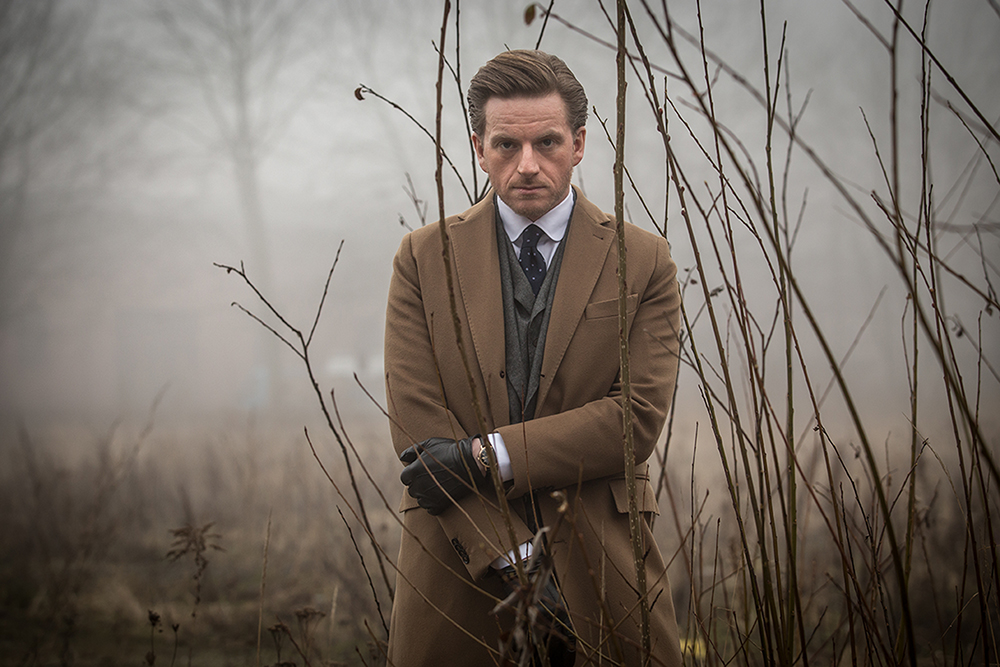
As is usually the case when making reportage portraits, many elements are unpredictable. It’s not always possible to plan a session like this in advance, you just find certain conditions and have to work out what to do. I was inspired by the fog and the landscape, which colour-wise turned out to be consistent with Szczepan’s outfit.
I took a few photographs changing the scenery slightly, but this is the one that finally made it to publication.
And working with Szczepan was very good – he was involved and patient, so I was still able to take an additional analogue portrait, for my One People Story project (about project HERE). As is my usual custom, when I have developed the negative and the photograph is ready, printed on beautiful matte cardboard, I want to give it to the portrait’s character. So, a few months later, I went to an author meeting and gave this photograph to Szczepan.
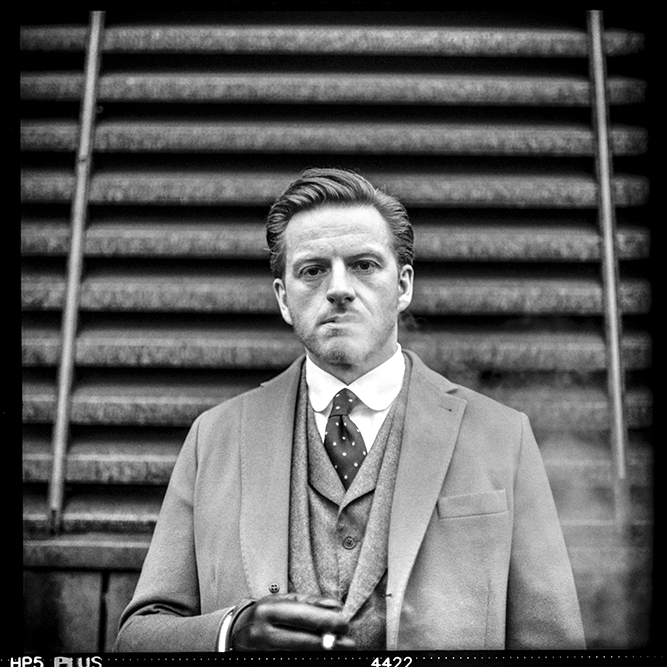
But back to the session in Gliwice: at the end, we took a backstage photo together, and some time later I received the information about the publication.
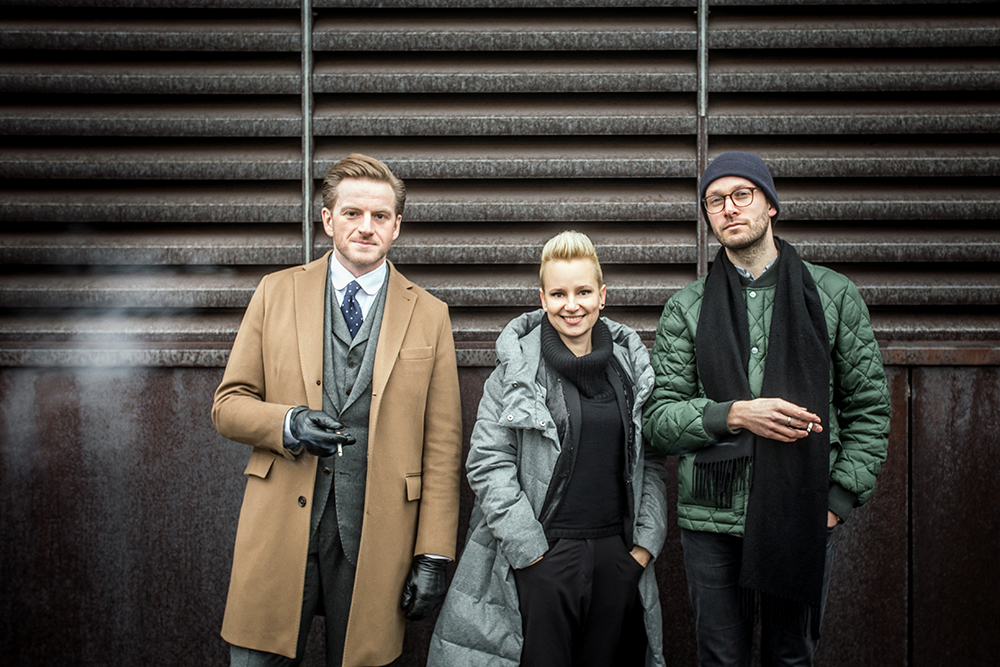
There is also an interesting thread about Martin Fejer – this was the second shooting I took for his agency, but we didn’t have the chance to meet in person until last year (2023). Martin lives in Budapest and on the occasion of my artist residency in Hungary we finally had the chance to see each other.
And Szczepan’s portrait brought with it another interesting surprise. A few months ago – six years after publication – I am found online by a client whose attention is caught by this photograph. The client likes the portrait so much that decides to offer me a collaboration.
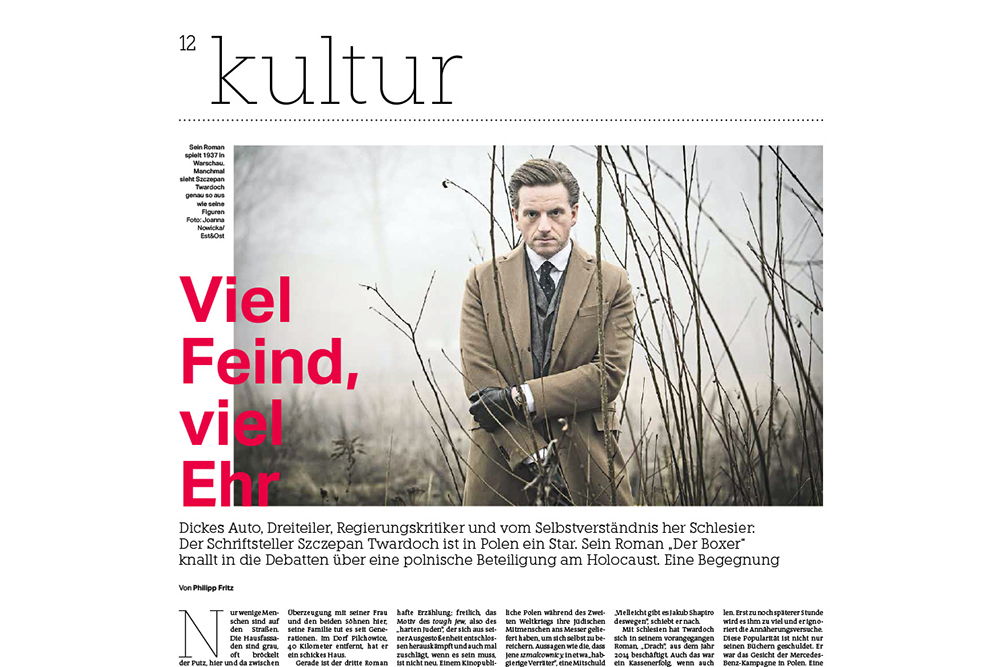
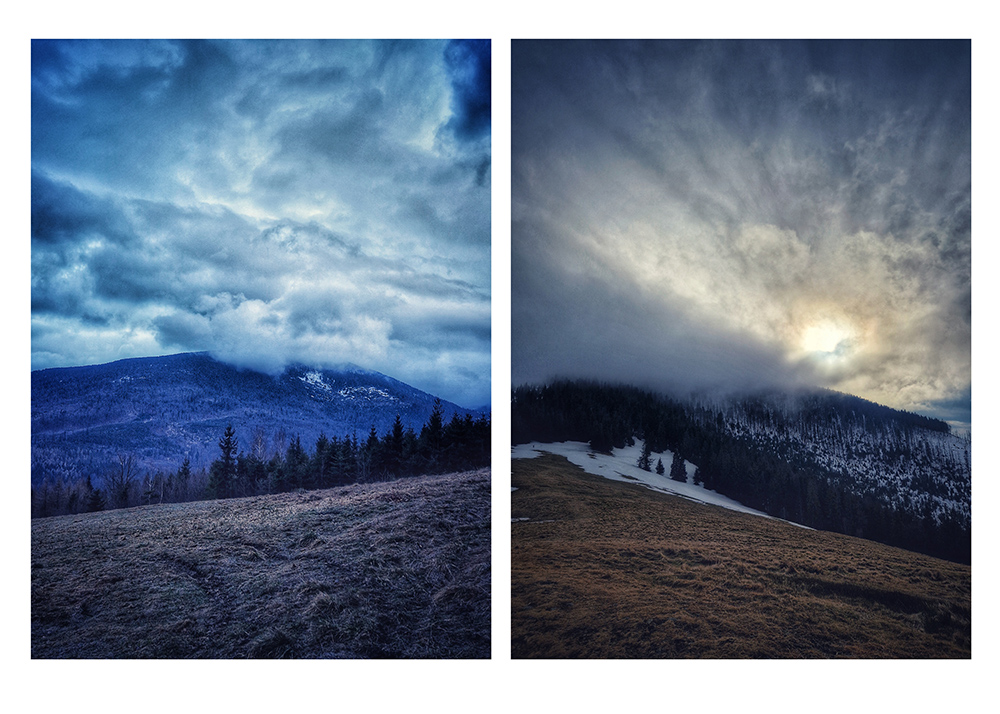
In the years when I worked as a photojournalist, I took all the equipment I was using at the time everywhere – my camera plus a couple of lenses packed in a sizable bag.
Too hard…
I remember holidays in Greece where I was carrying this heavy equipment with me everywhere. I took pictures of the sights, lots of souvenir shots.
When I arrived, I reselected the shots, prepared the selected ones and… abandoned them on the disk. I don’t remember if I ever showed them to anyone, although of course I could have made a holiday photo book (as some of my friends do) and had a super souvenir. It didn’t occur to me at the time, I didn’t feel the need to do so. The photos there were no different from the views available on the internet.
Before my next holiday trip, I already knew that taking all my kit wasn’t a good idea. I realised that by carrying so much gear every day at work and then on holiday, I didn’t make me feel that I was relaxing. The kilos weighing down my back, the constant attention to my gear to keep it safe. It just didn’t make sense.
Then I decided to bet on… two cameras 😉
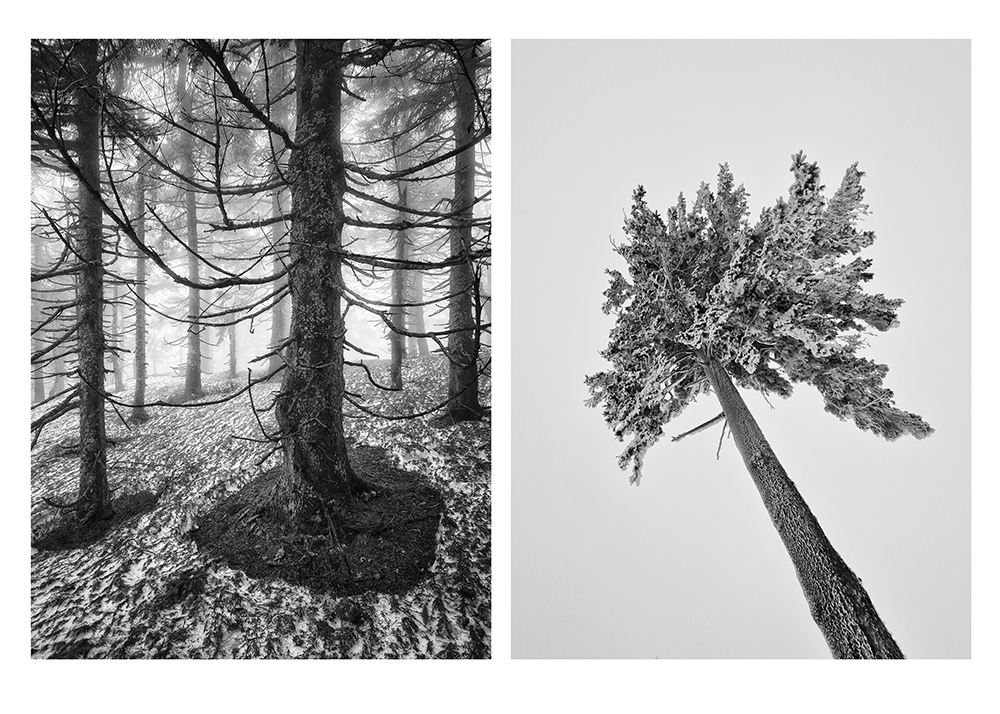
Mobile photography
The first is, of course, the one on my phone. It is a diary for capturing curiosities, nature and photos with the people I meet on my travels. When I changed my phone I made sure it had a better camera. I like to frame vertically and I run the best shots through Snapseed, a free photo editing programme on my phone.
The photographs that decorate this text were taken with my phone, during my recent holiday in Italy, and the forest and mountain frames during weekend trips to the Beskidy Mountains. For my needs of keeping a visual diary of the places I visited, they are completely sufficient.
Analogue photography
The second is my medium format analogue camera, which I have in a completely basic version: one lens, one cassette, I throw a few ISO 400 negatives in my bag – that is, with a fair tolerance for different lighting variations.
It’s a pleasure to catch situations, people, places that fit wonderfully into my One People Story series (take a peek – the link to the website is HERE). The photographs are on the one hand a reflection of a journey, on the other hand part of a larger project.
I happen to take just a few frames and that for me is very ok. I am not in a hurry with this kind of photography, I am not chasing tourist attractions, I am trying to see and explore, and above all – to be.
The holiday season is approaching, so choose whatever equipment you are most comfortable with and enjoy your time off.

I remember our first meeting. It was in 2021, as part of the Art in the Service of Spirit and Body (Sztuka w Służbie Życia i Ciała) series organised by the Art for Life Foundation (Fundacja Sztuka dla Życia). My Portrait Studio was hosting a photo shoot entitled Portrait of a Woman. You entered the studio beaming with joy and turbo energy, you indicated that you were very excited about the session and looking forward to it, and that as soon as you finish treatment, your wound heals, you absolutely want a portrait with that scar. At that time you were in the middle of chemotherapy, bald, without eyebrows and eyelashes and just before your mastectomy. You were suffering from breast cancer.
I admit, your attitude made an electrifying impression on me. Did you have absolutely no worries, doubts, fears about immortalising yourself in such an image?
Let me start by saying that the workshops I attended (also as part of the before mentioned series) contributed very positively to the progress of my treatment. The weekly trips to the Academy of Fine Arts in Katowice, where we did wonderful things acting through art, is what I love in hundred percent. Art allowed me to get through my illness more easily.
I looked in the mirror and saw my face completely naked, with no hair, eyebrows or eyelashes, and I realised that this could be a stage image. I was able to turn this into action and I regret at the moment that I took so few photos of myself at that time. I know now that if I had to shave my head as part of some artistic endeavour, I would do it without a problem. When hair grows back, it’s like a person is born again. I love change, it’s a part of my character.
So if you hadn’t attended the workshop would you not have turned up for the session, or would you have turned up but with a slightly different attitude?
I probably would have come, but one thing stemmed from the other, I treated the session like a reward. I was already interested in photography then, but maybe I was more reluctant to expose myself than I am now.

Exactly, because it must be mentioned that you experiment with your image, you create montage photographs, processed self-portraits. You show yourself, sometimes your nakedness, clearly the stereotypical ‘pretty look’ is not a priority in your work. You use yourself as a material.
I love turpitude in art, so I can do anything with myself and I’m fine with it. I love myself in every look and appearance. This character trait, has helped me to accept my new look. For many women, losing their hair during treatment is the end of the world, they lock themselves away at home, they don’t want to show themselves in public. I walked around with a bald head the whole period of chemotherapy and it didn’t bother me at all, in fact I felt like a mythical, strong amazon. Besides, it was a temporary state and I saw shaving my head as a gesture of standing up to fight, I felt like a warrior.
How did you accept the situation – the cancer treatment and consequently the loss of your breasts? How did you work with yourself to accept what had happened and – changed but happy – move on?
For me, experiencing cancer was not a negative thing. It has built me up, made me even stronger, opened me up more to art. For example, I recently took part in a body celebration class in nudity. It’s brilliant, this shamanic strength and power of women is very uplifting.
I’m not thinking about breast reconstruction. I love the asymmetry, and I can’t stand artificiality, I won’t do anything that is unnatural. I have accepted the changes. And the new folds of fat, because skinny I used to be. I’m different, I’m older, I’m more mature and it’s a natural process. You can’t look the same as you used to when you were 20. You can’t fight against time.
A year later we met again in my Studio and did what you announced. The result was a portrait with a visible mastectomy scar. I remember, you talked about your body then with complete acceptance and tenderness. Was it always like that? Have you always treated yourself well and accepted your appearance? Did this perhaps change when confronted with the difficult experience of oncology?
I was a fat kid as a child, my relationships with my peers were not good, so as a result I became a slacker. And what is funny, till today I have been left with an aversion to sport, PE was my weak point.
I created my own world, I read a lot of books, I was a good girl, a perfect child. In the eighth grade I grew and got slimmer a lot, thus it was easier with self-acceptance, but in fact I was never very complimentary.
And over the years I felt, now in adulthood, that something was wrong, I noticed that I wasn’t making myself happy, that I was getting along with everyone around me without taking care of myself. And it finally blew up. On the occasion of my divorce I went through therapy, I went from a pupa to a butterfly, I blossomed, I felt alive. That was in the early 2000s.
My childhood experiences have influenced my adult life: I’m not a herd person, I’m an individualist.
And nowadays I just take care of myself, I try to eat well and moderately. I’m greedy for life, I want more and more of it. Evidently the madness turns on in me at a ripe old age! I started hiking, I travel, I want to be close to nature, I want to feel life, I catch every opportunity.
But ultimately it was art that made me accept myself totally. I got to know performance theatre, real theatre, without artifice, falseness, and this art form seems the most authentic to me and I felt part of it. There is a fine line between art and life, for example, like Marina Abramović or Frida Kahlo. I am inspired by women artists, strong personalities.
I am not afraid of old age, I know how I want to live. I can’t bear to despair, to wallow in my sorrows. My character is so brilliantly constructed that if something bothers me, I get out of it, I change the situation like clothes. I need to have inner peace, then I feel good.

This is an extraordinary quality. When we are faced with a difficult change that requires us to rearrange the blocks and put a piece of our lives back together, accepting that the new helps us to move on. Do you share your own experiences to help others?
I deal with women who are going through what I went through and I see that talking about my approach to the situation helps them. They look at pictures of me from that time and become convinced that it might be worth facing their new image. I am approached by colleagues, or their friends, for words of support and advice. For example, I once gave a tour of the oncology department in Gliwice to a friend who was just starting treatment.
You can’t just shut yourself up at home and not talk about what you’re struggling with. I have encountered great kindness and words of support from people at a time when I really needed it, people want to help. For example, a neighbour brought me a homemade cake. And my friends were planning a trip to Morocco together for the time when I finish my treatment. So it’s not possible to hide, to pretend nothing is happening, to sit alone at home.
I can already express what I think, feel and expect, I can fight for myself. I am a tangible living example that it is possible to go through this process and live a normal life.
If there is someone who is reading our conversation and needs support on topics related to cancer treatment, can they reach out to you?
Yes, I am ready to help, happy to talk and share my experience. You can write to: gabrielaxy@wp.pl.
Thank you Gabrysia for an inspiring talk, I wish you all the best!
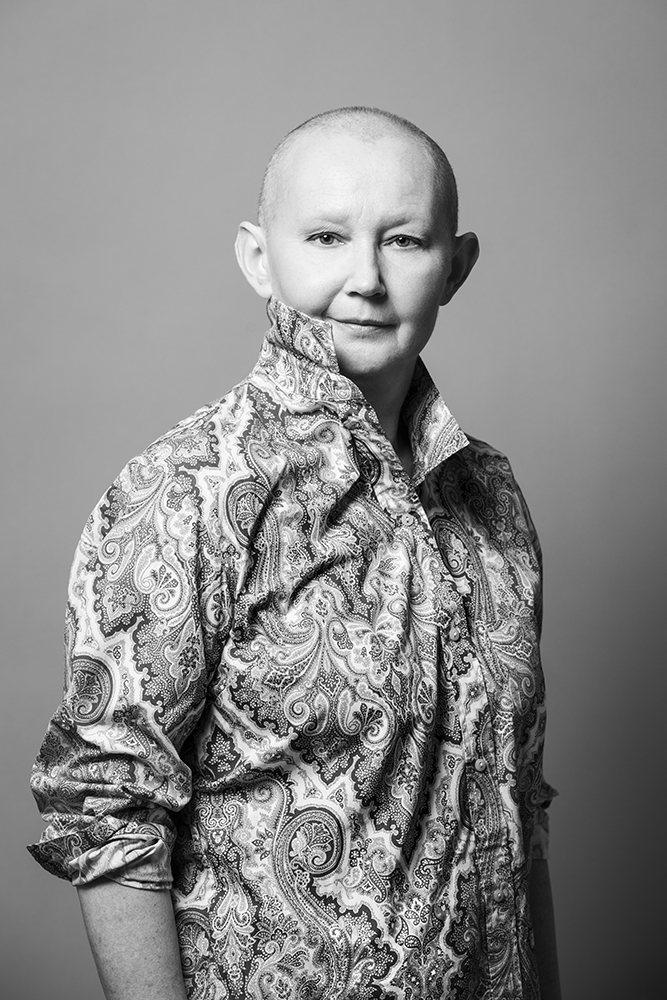
The portrait above is part of a series entitled Beautiful People.
Imagine you see an interesting person in the street and you intuitively feel that it would be a beautiful portrait. Nothing easier – walk up, introduce yourself, ask if you can.
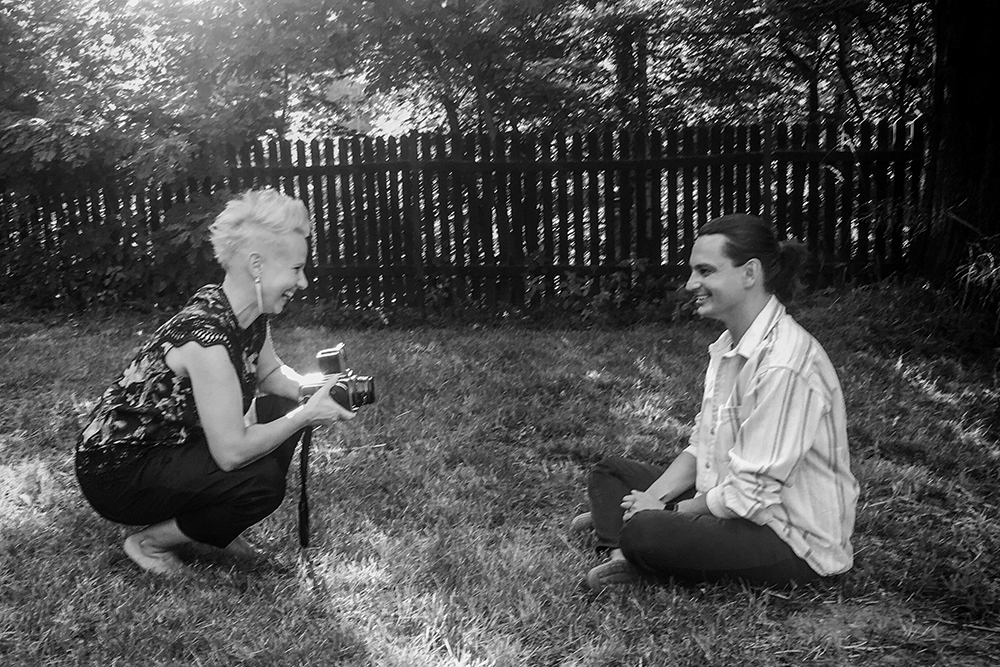
If only it were that easy… Many photographers have a big problem with it.
Fears are triggered: I don’t know how he’ll react; he might think I have bad intentions; he’ll float me away; he won’t give me a chance to finish my sentence; I won’t convince, I’ll get entangled and come across as a fool.
Do you know it? I’ve been portraying for years, and I still happen to feel this way.
When clients come to my studio for the headshots or portraits, it is always their initiative. When I want to do a portrait for my project, I arrange the situation, it’s my idea and it’s up to me.
A portrait is about meeting, establishing a relationship deeper than just a passing conversation.
For a portrait to have a chance to be good, deep, in my opinion, I should open myself up first. The photographer begins this relationship. I try to be honest, straightforward and curious about the other person. I stand in this openness, hoping not to be met with strong opposition.
In the portraiture, personality is important to me; what is outside is a manifestation of what is inside. I try to capture character, a certain trait, those qualities that have caught my eye and enthralled me. This means that I get close (not only in the physical sense), I speak openly about what I see, I arrange the situation as simply as possible. I want my intentions to be clear and the situation to be real. I won’t be able to make an interesting portrait if I don’t establish an understanding with the person I want to portray.
If I’m photographing for the One People Story project, the situation happens here and now, which sometimes makes me act by surprise. These are spontaneous street encounters or in the context of being together – at a concert, event, etc. I always get in contact with the person photographed and get back to them as I complete the process of creating an analogue image.
On the other hand, if I invite someone to participate in the Beautiful People series, there is a little more time to think things through before we meet in my Portrait Studio. I always let the person know how to prepare for the session, we start the session with coffee, there is time for conversation. I am committed to making the person feel comfortable in the space of my Studio, I take things slowly.
How to start? By smiling, introducing yourself, specifying what you want to do. I always ensure my intentions are good, I have nothing photographically to hide and you can have a glance at what I do on my website.
Have I ever met a definite rejection? No, but it will probably happen to me sooner or later. It is not a rule that people always say ‘yes’. Luckily, I hear a lot of good words: “you made me happy”, “I was very surprised but happy”, “you made my day, I felt great”.
Then I experience joy, too. I feel that we are entering some kind of exchange process, I feel excited and curious what we will create together.
I’m learning to listen to my intuition, it cannot, after all, give me wrong cues. If it signals that it is this character and this moment, I know that by being a coward I will lose the chance of a nice meeting and a good portrait. How many times it happened… I think there are still more portraits that have only existed in my imagination than these that have finally been created.
I hope to reverse this result one day.
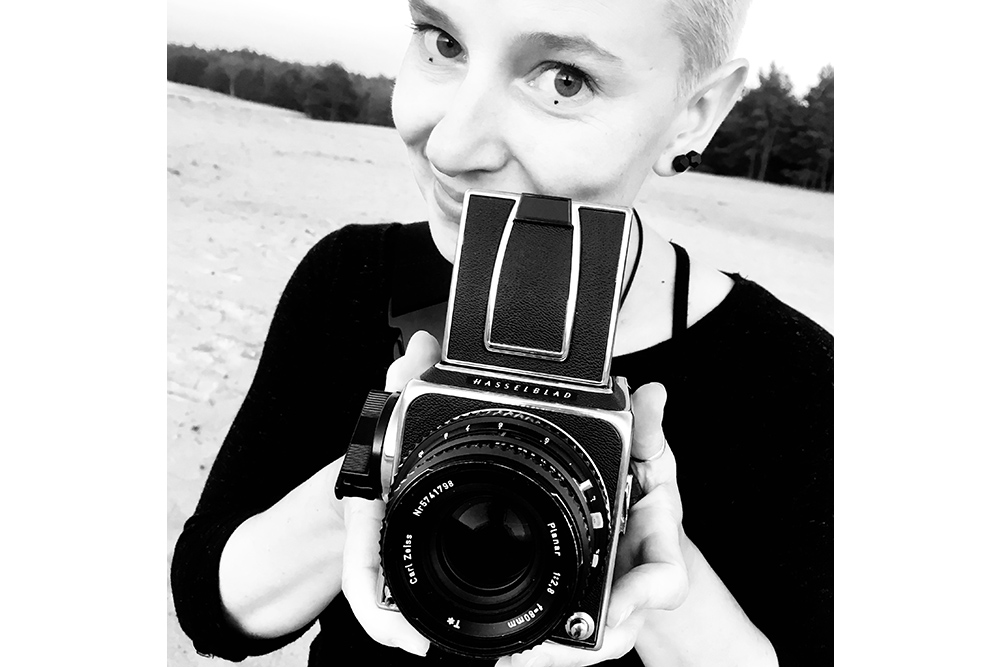
Header photo by Eric van Nieuwland.
Hi Marta! We met this year (2024) in my Portrait Studio thanks to the Cykl w Służbie Ducha i Ciała (Art in the Service of Spirit and Body Cycle) organised by the Sztuka Dla Życia (Art for Life) Foundation. You took part in a photo session called Portrait of a Woman, for women experiencing cancer.
Please tell us your story.
I got ill at the age of 31 and was diagnosed with breast cancer. At first I was given infusion chemotherapy and then underwent a mastectomy with the removal of lymph nodes. Despite this treatment, I still had some cancer cells in my body, so another chemotherapy was implemented, this time with tablets and hormone therapy. While I got through the first chemotherapy reasonably well – I lost my hair and was weakened, the second one swept me away. I was in pain and had numerous side effects, which I have been battling with to this day.
I was diagnosed in 2020, the treatment lasted almost two years.
You caught my attention with your openness, joy and courage – you wanted to photograph yourself in such a way that the absence of one breast was visible. Didn’t you hesitate at all?
I’ve had the idea of doing a portrait session for a long time, even before I got sick. Well, I didn’t do it at that time and I’m glad I finally got in front of the lens. I noticed on my friend’s social media profile a post from last year’s Portrait of a Woman session and an announcement about the next edition. I wrote straight away registering my desire to participate.
I had no reluctance. I knew that sooner or later these photographs would be published, so I came with a message for others. I wanted to tell women that they have nothing to be ashamed of. They are fighting a hard battle for life, they shouldn’t worry about losing their hair. Even the loss of a breast – reconstruction can be done, we have the right to do it and it can be fixed somehow. Life is the most important thing.
So taking part in the photo shoot – it took me 30 seconds to decide! – I wanted to ensure that even after such experiences, a woman still remains a woman, with all her femininity – her smile, her happiness, her passions. Appearance changes in life, I used to be very slim, then I weighed more, and now that weight will fluctuate too, because I’m on a strong hormone treatment. But I’m not going to hide under baggy clothes, being a bit chubby doesn’t mean you can’t wear a dress. If I feel good about myself, that’s the most important thing. Self-acceptance is important, especially as there are things beyond our control.

You sound like you accept yourself unconditionally. Has it always been this way, or has it only been your time of illness that has turned your attention to the fact that there are important things and more important things?
I didn’t have that before. I used to pay a lot of attention to how I looked and had trouble with it. But I have a feeling it’s because of other people. I had a hard time in primary school and then in middle school. I have a big burn scar, it takes up half of my chest. At the age of three and a half I spilled boiling water on myself and my plastic shirt stuck to my skin causing these scars as a result.
So I was rather scapegoated at school, I didn’t have it easy.
So we have had similar experiences. When I was a few years old, I pulled a pan of hot oil down on myself. I burned half my face on the border with my eye and my cleavage. The doctors told my parents that I would have a series of plastic surgeries because the scars would be considerable. By some lucky coincidence, my parents got hold of a medicine which, as a foam, solidified on the burned skin in such a way that no dressings had to be made. Changing them, and thus disturbing the skin, could cause scarring. The result is that, with the exception of a small mark on the clavicle, the rest of the skin has regenerated 100 per cent.
But leaving my experience, and coming back to you – both the burn and the cancer are the same side of the chest?
Yes. After the burn, the doctors said to wait until I grew up, mature and my breasts grew, because then a skin transplant would be possible. I waited until I was 15 to do that. And then, when I started to find out what it was going to look like, that the skin would have to be taken from my leg, I decided that I didn’t want it. That I accepted this scar and my appearance. I wore blouses with deep necklines, not caring about the comments of others. Definitely my self-esteem went up a lot.
Later, I experienced a shake-up of my self-esteem again, contributed to by my ex-husband, from whom I eventually left, for myself and my child.
At the moment, after my oncology experience and the loss of my burned breast, I don’t pay attention to the little things – the extra kilos, for example – I know what this is due to. It’s not my carelessness, it’s the result of treatment. I have my limit of kilos that I don’t want to exceed, but I also don’t tire myself out at the gym.
You mentioned that you decided to have breast reconstruction.
Yes, I have decided. It won’t be perfect, there will definitely be differences between the breasts, but that’s okay.
But no scar removal?
No, no, it’s already my trademark! It makes me stand out, that’s who I am.
I feel sad when I see women trying to cover up their imperfections. While I was being treated, sitting in the hospital waiting my turn, I met a lady in the waiting room, about 70 years old. I had an uncovered bald head and a T-shirt that showed the absence of one breast. The lady (I later found out that she had undergone a double-sided mastectomy) came up to me and asked – how come I wasn’t ashamed, that I was sitting completely unbothered and not covering myself. I told her that for me it’s nothing terrible. On the contrary, it is the result of the fact that I am fighting for my life, that I have stood up to this fight. Then we saw each other again, this time she came up to me and hugged me and thanked me for being able to look at this case and herself from a completely different perspective. She pointed out that maybe she wouldn’t cover herself up so much by drowning in wide clothes anymore, that what others say might not matter.
Yes, because it’s not those others who are fighting, it’s me who was fighting, the lady was fighting and that was the most important thing. And not the stares of others.
Sometimes I wore a kerchief on my head, always some fancy one, with big bows, in flowers, foxgloves. I wasn’t hiding, I didn’t want to be a grey mouse, I wanted to feel good and use the situation to add colour.
I was only sick for a moment, I told myself. What you have in your head has a colossal impact on how the healing process goes.

My impression is that you now draw your self-esteem from inside you, rather than conditioning it by what’s on the outside.
Yes, but there’s no denying that the illness affected relationships. It tightened the bond with my friends and my sister but it also verified many other relationships, quite a few people left, my relationship didn’t survive. Well, my appearance turned out to be more important…. But I know that I won’t be with anyone just because I have to (because I might not find anyone else anymore), but because I want to. I have a few more kilos, I feel good about it. I look the way I look.
I started to fulfill my dreams, I took my illness as a warning not to put anything off. I recently returned from a trip together with my sister, we had never done this before.
My 16-year-old son has gone through an accelerated course of adulthood, sometimes he feels different, but it doesn’t bother him. We are both different.
I saw on social media that you are running a fundraiser for your cause. Tell us more about it.
I used to think I could handle everything myself. Life has verified that. Illness is one thing, but it’s still important what happens afterwards. I have to have regular checkups and I’m constantly on medication. Chemo has ruined my teeth, which I want to heal.
Therefore, I decided to set up an account with the Alivia Foundation and run an oncology donation, thanks to which I do not have to worry about money for necessary expenses related to the consequences of the disease. I am grateful to the donors for these contributions.
Marta thank you very much for your honest conversation and I wish you all the best.
Marta’s fundraising link: onkozbiorka.pl/marta-stachowicz
I work sometimes with clients who were disappointed with their cooperation with the previous photographer and were not satisfied with the result of the photo shoot.
Photography is an absolutely democratic field, it can be practised by anyone and at any level of commitment – occasionally, as a hobby or professionally. You don’t need any school or certificate of qualification to practice this profession. In fact, everyone takes photographs.
So, how can you find the perfect photographer to work with?
Most often clients come to me through recommendations. They already know who I am and what I do. Nevertheless, I make sure they have seen my portfolio.
I work in a certain style and convention. This doesn’t mean that I can’t shoot differently, it just means that my style is what I do best. If you see my portraits and you like them and you know that it is something you want, the chances of me meeting your expectations increase.
You don’t have to know anything about photography of course, the like/dislike category is already a good start. The reception of photography is always correlated with our sense of aesthetics and taste, so the chances of you being satisfied with the result are bigger if you simply like the photographer’s work.
But it’s definitely worth checking a few things before you order a photo shoot.
Creating my brand and running my photography business professionally, I take care of my development, high quality of photographs, professional cooperation with clients. This is the sum of experience gathered over a dozen years of practice.
So check the experience of the photographer you want to cooperate with, how long he/she has been on the business.
Of course, everyone started out once and you can’t build up professional experience any other way than through practice. It’s a known fact. But it’s just good to know that you are entering a cooperation with someone who has had a few assignments in a particular field, not a few hundred.
My first years in the profession I worked as a photojournalist. Since then I have covered a great variety of subjects, so I feel I could shoot in many areas of photography. However, I am a fan of specialisation.
Investing in the specific photographic equipment, improving skills, gaining experience by concentrating on a narrower branch of photography all mean that over time a photographer is seen as a specialist in his/her field.
So if you want to do a photo shoot of your products, find a photographer who specialises in product photography. He or she will be able to manage photographing, for example, shiny, reflective objects, and will have ideas and materials for arranging the scenery. A portrait photographer, on the other hand, in addition to technical skills related to, for example, studio lighting, should also have interpersonal skills – be able to create a friendly atmosphere and good relationships as these skills will affect your comfort on set.
Each field of photography requires to put accents in a different area, so choosing a specialisation is conducive to the pursuit of mastery.
And finally, it is a good idea to talk to the photographer first, either by phone or in person. A good relationship is important. If you feel that you understand each other well, the conversation is productive and the collaboration will deliver what you expect you can proceed to discuss the details.
Conclusion: portfolio, experience, photographer’s specialisation and good energy between you and photographer – pay attention to these elements before you decide for a photo shoot.
